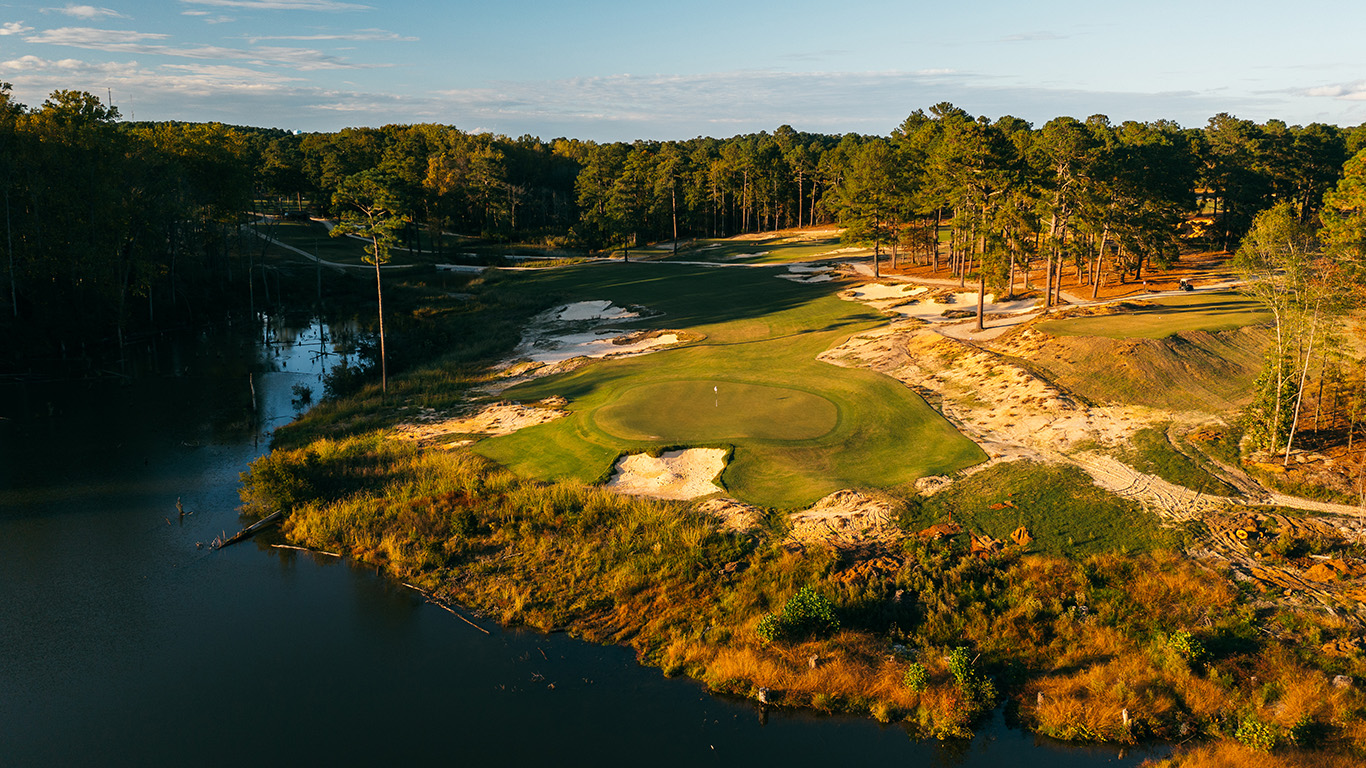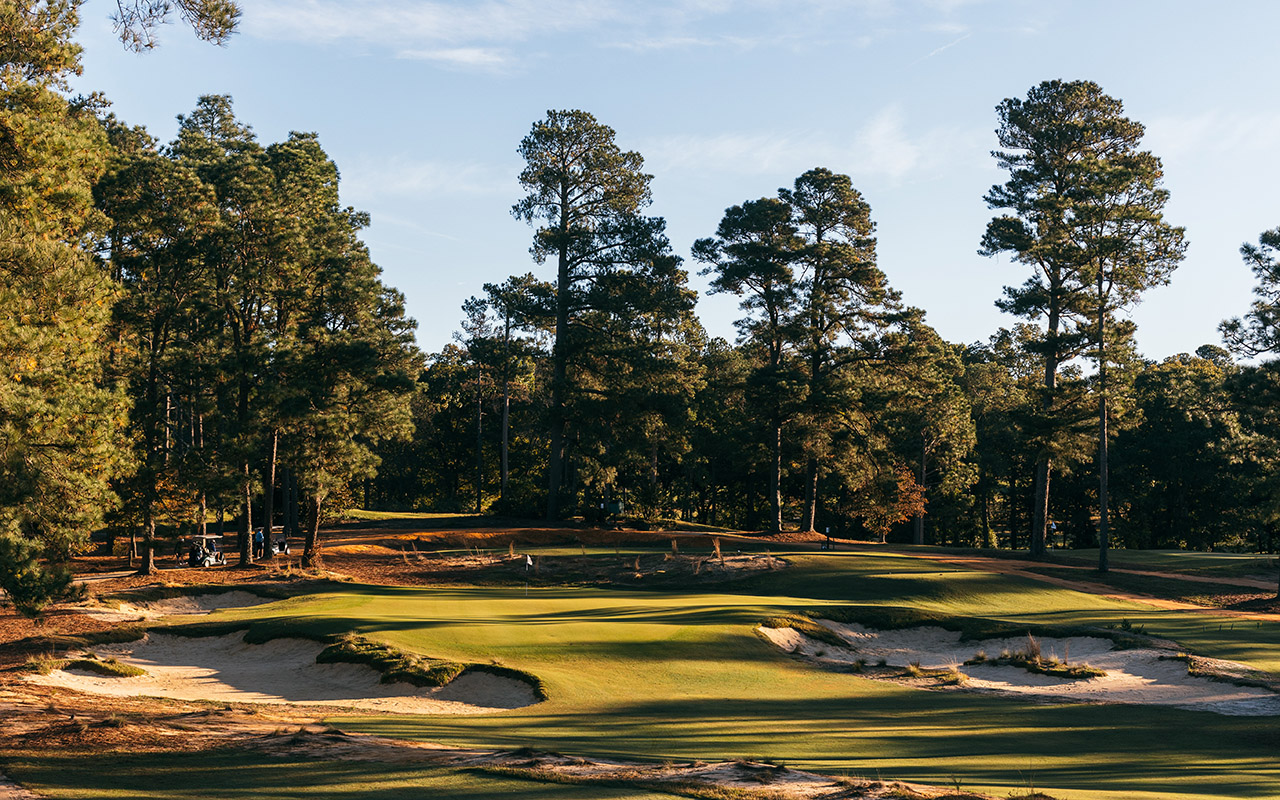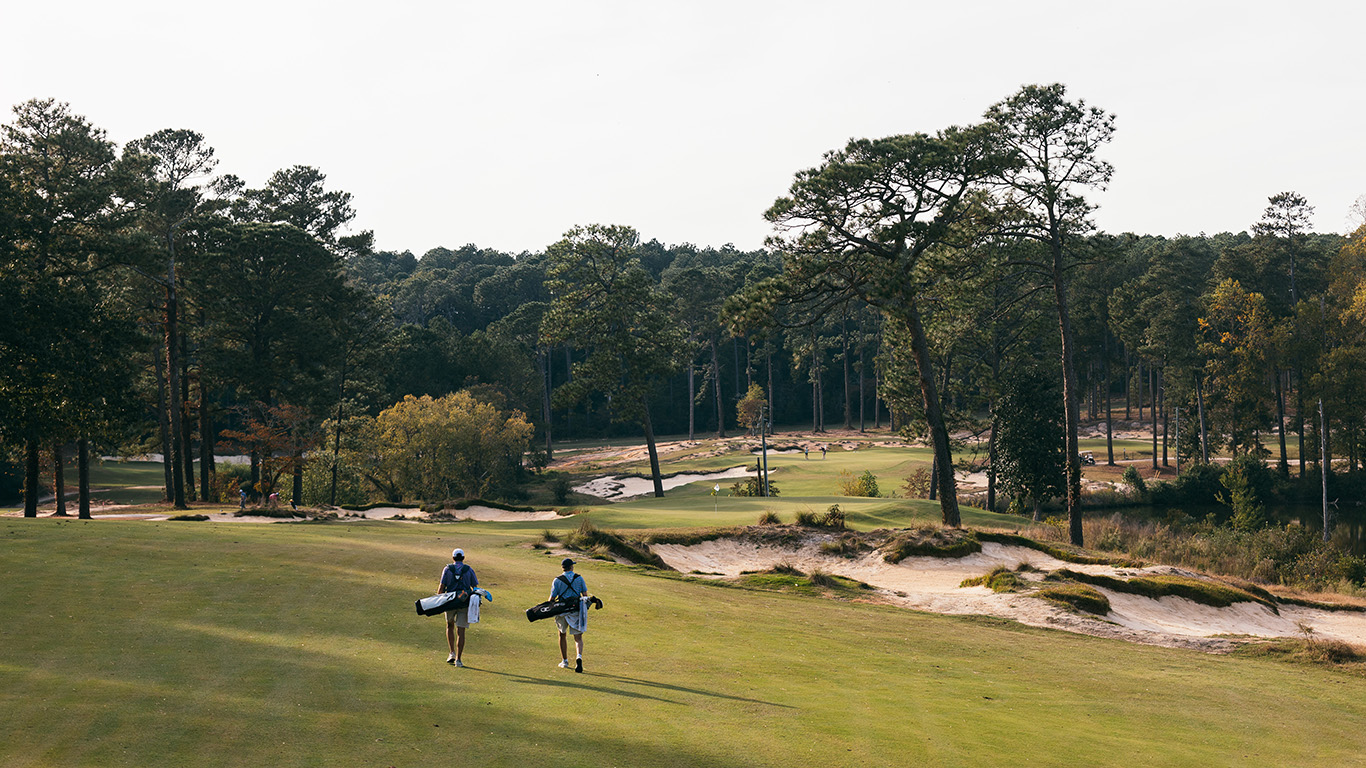Ernest Hemingway once said that all modern American literature comes from Mark Twain’s Huckleberry Finn. Pinehurst No. 2 is the Huck Finn of American golf, its influence present in nearly every well-known course built since the end of World War II. Much of the talk about No. 2 revolves around the turtleback greens, which have speeds just north of your kitchen’s hardwood floors, but it is Donald Ross’s subtle routing that makes the course so special. Framed by loblolly pines, the playing corridors feel expansive and intimate all at once. You feel sort of carried from each green to the next tee. Everything about No. 2 is efficient—except for the number of strokes you’ll take getting around the property.
Perhaps the most remarkable thing about the course is that it’s on unremarkable land. The only substantial elevation changes occur early on: the fourth hole starts on a slight hill and works its way down; the fifth rises back up. This dip and rise is the only time your legs will grind until you climb the eighteenth fairway. The lack of topographical drama is one reason that Gil Hanse’s recent work next door on No. 4, with its bountiful eye candy carved into hills, has caused such a stir among architecture enthusiasts, whispering—wondering—if it’s the better course. (It’s not.)
While Ross showed his genius at No. 2, he eventually got to work on better land in the same area. With Mid Pines, Pine Needles, and Southern Pines—all within a short drive of the Pinehurst Resort—he produced a trio of gems. Yet just 10 years ago, all three were overgrown and worn down, drab even, despite their wonderful terrain, which allowed for blind shots and long, loping drives to tumbling fairways. Southern Pines in particular had constant elevation changes and serpentine movement in its holes, but it had become neglected. It was a little-known outpost in not so much a sea but a lake of bucket-list courses in the North Carolina Sandhills.
Enter Kyle Franz. First he renovated Mid Pines in 2013, then Pine Needles in 2017, bringing back the sandscapes and rugged edges that had once defined Sandhills golf. Kelly Miller, who has owned both courses since the 1990s, was pleased with the work, so when he bought Southern Pines in 2020, it was a no-brainer to hire Franz again. At Southern Pines, just as he did at Mid Pines and Pine Needles, Franz revealed a course that had been hiding in plain sight.

Photo credit: Matt Hahn
In September 2021, after eight months of renovation work, with more on the way, Miller reopened Southern Pines, and the changes were nothing short of breathtaking. The course, like many of the era, struggled because too much foliage—sorry, Mr. Player—was choking out sunlight and stressing the grass. “You could lose a shoe in the tenth fairway,” Franz said in mid-October. “In January we were having such rain and all those trees were still there. It was so dank and dark, the grass just never had a chance to dry out.” So one of Franz’s first orders of business was to take down some trees, opening up views across the course and allowing the turf to get sunlight and properly drain. “The conscious removal of trees and aerifying and getting air flow through and sunlight has the turf just loving it,” Franz said.
The best part of the old Southern Pines was its bentgrass greens, which were mostly hidden under the canopies of trees. Franz has now exposed them to the light and restored their contours, adding a flare here and there, such as a protruding knob that can repel rolling shots away from a pin.

Photo credit: Matt Hahn
Franz acknowledges that he incorporated his own voice into Mid Pines, Pine Needles, and Southern Pines, but he insists that his main purpose was to “serve the song.” “We are trying to get it where we have the right bass drum and guitar notes in there,” he said. Music is a big thing with Franz, and he refers to it and the Beatles frequently when discussing his craft. He emphasizes hitting the right chords, the right notes—and indeed little seems out of place at the refreshed Southern Pines.
If one must criticize—and one mustn’t, to be clear—it could be said Franz’s work at Southern Pines feels similar to what he did at Mid Pines and Pine Needles. But the aesthetic of sand encroaching on soil, framing fairways and greens, is not likely to go away anytime soon, nor should it, when the alternative was apparent in how these courses looked before Franz got his hands on them.
Besides, this design style isn’t just about the visual technique of breaking up a continuous canvas of green; it’s also about strategy. Depending on the hole, the sand can point you away or toward trouble. It gives the golfer something to ponder on each shot, a set of cues, sometimes unreliable, about where to aim. There used to be one route at Southern Pines, one way to play. Now it’s more choose-your-own-adventure friendly.

Photo credit: Matt Hahn
Above all, Southern Pines shows Donald Ross’s restraint, how he was able to let a dynamic piece of land do the hard work of challenging the golfer. Aggression on downhill drives leads to trouble. Mis-clubbing on your approach leads to bogey on worse. The course uses the constantly moving topography in a way that blends strategy with chance. There are days when the turtlebacks are impossible at No. 2, but the fairways are always level there; at Southern Pines, the fairways bend and rise and fall. The bad breaks are just as varied and surprising. This kind of difficulty, when viewed with the right attitude, is a pleasure and can be found at all corners and from all angles. There is more to curse—and rejoice—than your wedge play.
But No. 2 v. Southern Pines isn’t Brooks v. Bryson, where you hate both (you do dislike both, right?); or Arnie v. Jack, where you have to pick the one you love. Both are sublime. Both are golf at its best. Ross may have tinkered with No. 2 his whole life, but at Southern Pines he did more than enough.
Michael Croley is an assistant professor of English and journalism at Denison University and the author of Any Other Place: Stories. His writing has appeared in The New York Times, Esquire, The Paris Review, and elsewhere.
See more of Matt Hahn’s photography and videography here.


 by
by 
